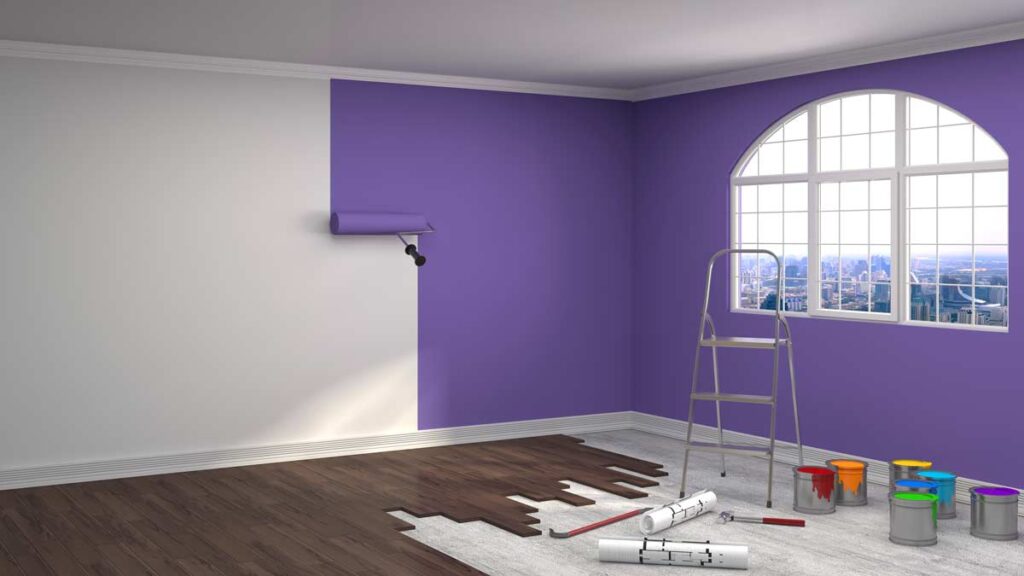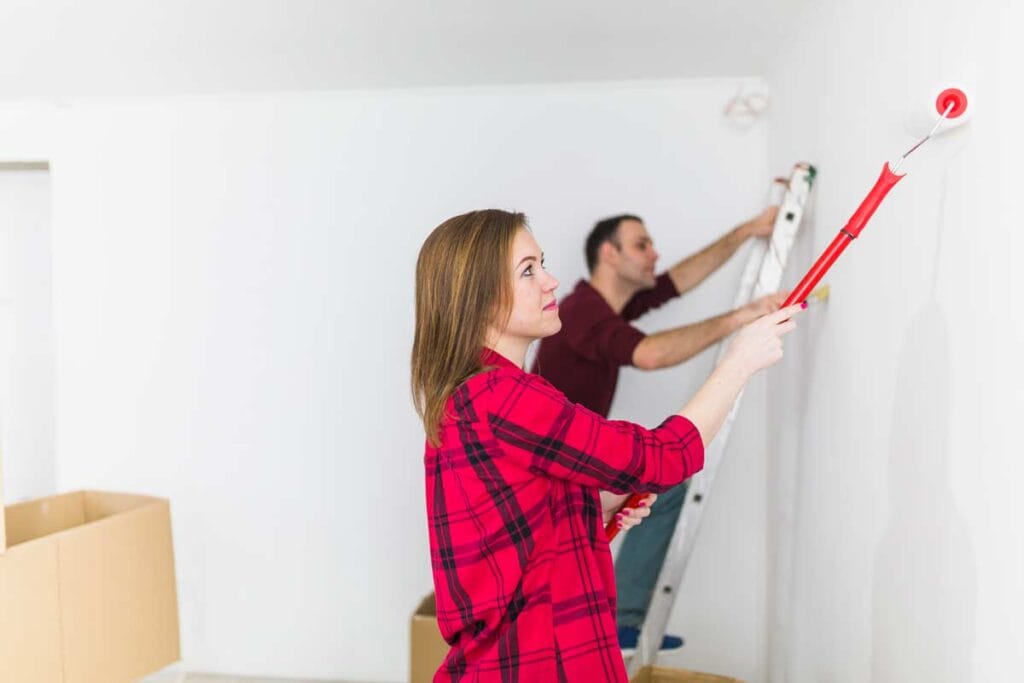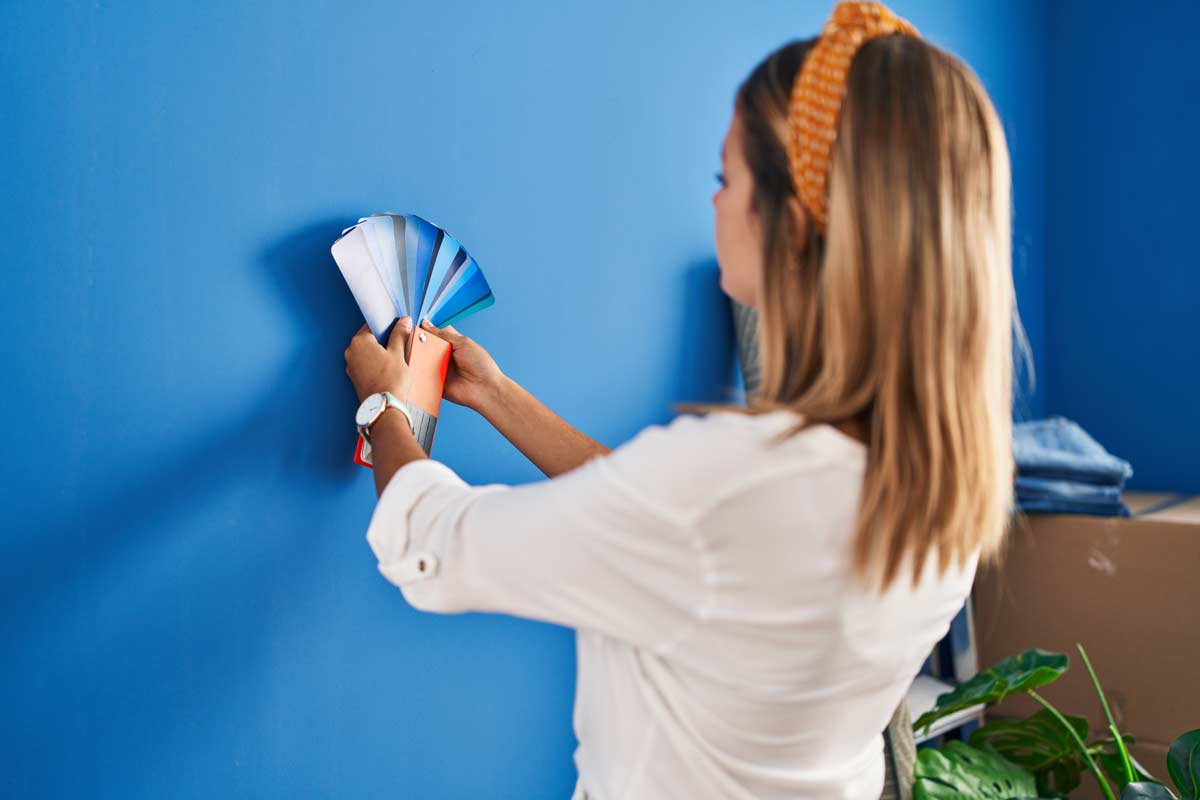- Free Estimates

Two-tone walls bring new life to living rooms by adding depth, dimension, and a burst of visual interest. This modern repainting approach allows homeowners to play with color contrast, highlight architectural features, or subtly define zones within open spaces. When done right, it turns a plain wall into a bold design statement—without overwhelming the room.
Here are five two-tone wall repainting ideas for living rooms that pop.
✔ Two-tone walls add depth, contrast, and personality to any living room.
✔ Matte and satin finishes work well together for stylish, low-maintenance results.
✔ Proper wall prep and priming before painting ensures smooth coverage and clean lines.
✔ Vertical, diagonal, and framed accent styles offer modern twists on classic designs.
✔ Professional interior repainting contractors deliver crisp lines and lasting results.
✔ Always test paint colors and finishes on both drywall and plaster before committing.
✔ Trusted interior wall painting services make the repainting process faster, cleaner, and stress-free.

A timeless choice, this two-tone style splits the wall horizontally—usually at chair-rail height—with a bold color on the bottom and a lighter shade above. It works well in both traditional and modern living rooms, offering a clean, structured look. This approach adds balance and makes ceilings feel taller.
For those looking to break away from the expected, a vertical split creates a bold, modern feel in a living room. This technique divides the wall from top to bottom—either at the center or offset—for a clean, dramatic effect. It pairs especially well with minimalist or contemporary interiors.
Instead of confining color to the walls, painting the ceiling a contrasting or coordinating hue adds instant drama. This design flips expectations, pulling attention upward and adding a polished, custom feel to any living room. It’s especially effective in rooms with high or vaulted ceilings.
For artistic and energetic living rooms, a diagonal or geometric color divide adds movement and creativity. It’s ideal for modern homes and open-concept spaces looking to avoid uniformity. This bold choice demands precision in both design and execution.
This idea starts with a single accent wall and adds a second tone as a frame—either around the edges or in vertical/horizontal panels. It’s subtle but powerful, turning one wall into a design centerpiece.
Choosing the right paint finish is just as important as picking the perfect colors. In two-tone designs, the sheen or texture of the paint affects how light reflects, how colors interact, and how the room feels overall.
Different wall surfaces—like drywall and plaster—also respond differently to finishes, which is why working with interior repainting contractors ensures better results that last. And with the average cost to paint the interior of a house around $2,021, it makes sense to invest in a finish that looks great and holds up over time.
Matte finishes are great for top wall sections because they absorb light and reduce glare. This creates a calm, understated background that won’t overpower artwork, lighting, or architectural details. When repainting interior walls, matte paint works well over properly primed drywall or plaster, especially when handled by pros familiar with wall prep and priming before painting.
Eggshell offers a slight sheen that reflects just enough light to give walls a smooth, clean look. It’s a smart pick for the lower half of two-tone walls where scuffs and fingerprints are more common. Many interior wall painting services recommend eggshell finishes when repainting drywall and plaster in high-traffic areas like living rooms.
Satin finishes work well for both upper and lower tones depending on the room’s lighting. They’re more reflective than eggshell but not as shiny as semi-gloss, making them ideal for walls that need to be wiped clean regularly. When interior repainting contractors use satin over well-prepped surfaces, the result is sleek but not overpowering.
Semi-gloss is rarely used across full walls, but it’s perfect for highlighting frames, baseboards, or panel dividers in a two-tone design. Its shiny finish adds visual definition and resists moisture and dirt, making it easier to maintain. For best results, painters often apply semi-gloss after completing all repainting interior walls and letting the base layers cure fully.
Glossy paint reflects light sharply, which can make even minor imperfections stand out. Plaster walls, especially older ones, tend to have texture or patches that glossy finishes will highlight in unflattering ways. Skilled interior wall painting services typically avoid gloss when repainting drywall and plaster, unless the surface is perfectly smooth.
Paint finishes can look very different in natural vs. artificial light, and colors may shift slightly depending on the sheen. Testing small sections on both the upper and lower halves of the wall helps reveal how each finish will behave. Before finalizing a decision, it’s smart to consult interior repainting contractors who understand how wall prep and priming before painting affect finish performance.
 How Proper Wall Prep and Priming Lead to Smooth Results
How Proper Wall Prep and Priming Lead to Smooth ResultsEven the boldest color combinations can fall flat if the wall isn’t prepared correctly. Successful two-tone designs depend on smooth surfaces, strong adhesion, and precise lines—all of which start with careful wall prep and priming before painting. Whether working on drywall or plaster, a clean, even foundation makes every layer of paint look better and last longer.
Dirt, oils, and old residue can prevent paint from sticking properly and cause uneven coverage. Wiping down walls with a damp cloth or mild cleaner helps create a solid base before any primer or paint goes on. Many interior wall painting services include this cleaning step as a standard part of repainting interior walls.
Rough textures, bumps, and previous paint drips can show through a new coat if not addressed. Sanding the walls—especially patched or high-touch areas—ensures a flat surface for a crisp two-tone finish. This step is especially critical when repainting drywall and plaster, as both materials absorb paint differently without prep.
Tiny cracks, nail holes, or dents become more noticeable after paint is applied—especially when using bold or contrasting colors. Spackle or joint compound fills these gaps, and once dry, can be sanded flush with the wall. Interior repainting contractors typically inspect every surface closely before starting to guarantee a flawless repaint.
Drywall and plaster require different types of primers for proper adhesion and coverage. A drywall primer seals the porous surface, while plaster may need an oil-based or specialty primer to prevent peeling. Wall prep and priming before painting is where experienced painters make a big difference—matching the product to the surface makes the paint stay true.
Painter’s tape helps define clean lines, especially where two colors meet. However, poor taping or skipping prep can lead to bleeding or jagged edges. This is why interior repainting contractors take the time to properly prime and dry walls before applying tape when repainting interior walls.
Patches and shiny surfaces absorb paint differently and can stand out under the final coat. Applying a spot primer or sanding down glossy sections evens out the absorption rate, so the finished wall looks seamless. This level of attention matters most when repainting drywall and plaster with high-contrast two-tone combinations.
 Why Hiring Interior Repainting Contractors Makes a Big Difference
Why Hiring Interior Repainting Contractors Makes a Big DifferenceThe Painting Services Market is projected to reach USD 93 billion by 2031, reflecting growing demand for quality interior updates. This is because a professional two-tone wall repaint involves more than just picking colors and grabbing a brush. It takes precision, surface knowledge, and the right materials to pull off clean lines and lasting finishes—especially when working with both drywall and plaster.
Here’s why hiring professionals in Fairfield, CT, matter:
Drywall and plaster react differently to paint and require unique prep techniques. Pros know how to handle each material—whether it’s sealing porous drywall or priming fragile plaster—to ensure even coverage and long-term adhesion. When repainting drywall and plaster, this knowledge prevents peeling, streaking, or uneven results.
Surface preparation is time-consuming and often skipped in DIY projects. Professional painters handle everything from patching and sanding to selecting the right primer based on surface type. Their attention to wall prep and priming before painting ensures the new paint adheres properly and looks smooth from edge to edge.
Whether the wall split is horizontal, vertical, or geometric, getting crisp edges is no easy task. Interior repainting contractors use laser levels, painter’s tape, and methodical planning to prevent color bleed or crooked lines. Their accuracy is what separates a polished look from a rushed one when repainting interior walls.
Choosing the wrong finish or formula can ruin a great color choice. Professionals guide clients on matching finishes to each wall section—like matte on top and satin on bottom—for durability and style. Most interior wall painting services also know which products hold up best when applied over patched drywall or sealed plaster.
Painting a living room often means moving furniture, covering floors, and losing access to a central space. Contractors streamline the process, completing work faster without sacrificing quality. Hiring interior repainting contractors keeps the project on schedule and reduces the mess typically left behind after repainting interior walls.
A professional job doesn’t just look better—it lasts longer. From base coat to final touch-up, contractors build a finish that resists chipping, fading, and moisture damage. Their experience with repainting drywall and plaster ensures the two-tone design holds up under everyday wear and tear.
Yes, two-tone walls can actually make a small living room feel larger and more open when designed thoughtfully. Using lighter shades on the upper half creates the illusion of height, while a darker tone on the bottom adds depth. Repainting interior walls with strategic color placement helps visually expand tight spaces.
Primer usually needs 4 to 6 hours to dry, depending on the type and the room’s humidity level. Rushing into painting too soon can cause peeling or uneven coverage later on. Professional interior wall painting services always allow proper drying time as part of thorough wall prep and priming before painting.
Yes, but the finish differences must be intentional and balanced. For example, satin on the lower portion and matte above can create a subtle contrast in texture without clashing. Experienced interior repainting contractors can advise on which combinations work best, especially when repainting drywall and plaster.
Dust walls regularly and use a damp sponge or cloth for cleaning scuffs, especially on the lower half. Avoid harsh cleaners, which can damage the finish or alter the color. Most interior wall painting services recommend keeping leftover paint for touch-ups when repainting interior walls with bold color splits.
Yes, but the texture can make sharp color transitions more difficult to achieve. Using a quality primer and carefully applying painter’s tape can reduce bleeding on uneven surfaces. Skilled interior repainting contractors know how to prep and tape textured surfaces properly, especially when repainting drywall and plaster that isn’t perfectly flat.
Transform any living room with bold, beautiful color from the pros at Fairfield Painting Contractors. With expert knowledge in repainting interior walls, prepping drywall and plaster, and delivering clean two-tone finishes, our crew brings skill and efficiency to every job. Whether it’s a modern update or a classic refresh, homeowners in Fairfield, CT, can count on reliable service, attention to detail, and results that last.
Reach out today to schedule interior wall painting services that truly make a space pop.